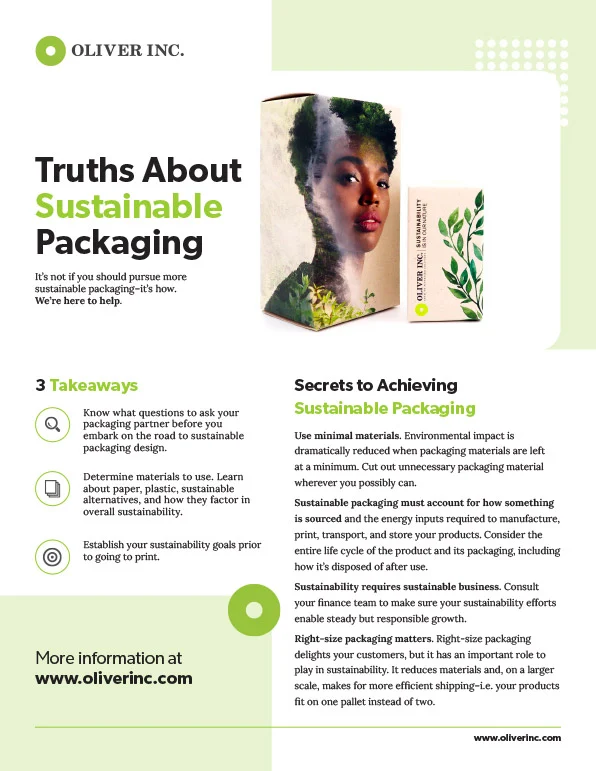Important Trends in Pharmaceutical Labeling & Packaging
Posted by Oliver Inc. on 14th Sep 2023
Packaging is perhaps the most routine point of contact consumers have with a brand, creating a tangible experience that establishes a company’s identity and conveys what it represents—perhaps even more true for secondary packaging and adhesive labels.
Compelling decorative elements, anti-counterfeiting technologies, and sustainable packaging are front and center for pharmaceutical brands today.
No doubt you’ll want to consider how these factor into how you design folding cartons for your pharma products, as well as blister cards.
So, let’s unpack some of the latest trends in pharmaceutical labeling and packaging.
Anti-Counterfeiting for Pharmaceuticals
Not just the purview of unlawful money printers, counterfeiting in packaging has been gaining traction in our e-commerce world. Criminals are tampering with products and reselling them online, or packaging knock-off items and peddling them in illegitimate packaging. In response, retailers are leaning into anti-counterfeiting components in pharmaceutical labeling and packaging.
Counterfeit items can corrode consumer trust in a brand and undermine potential sales. Plus, efforts to remove this unauthorized merchandise can be costly. For example, counterfeit medicines may have either ineffective pharmaceutical qualities, no active pharmaceutical ingredients, or contain substandard formulations. In worst-case scenarios, they can be fatal.
Fortunately for pharmaceuticals, labeling and packaging have developed anti-counterfeiting capabilities. It’s worth noting that while anti-counterfeiting technology can’t prevent criminals from modifying your products, it can provide retailers with an effective way to authenticate pharmaceutical packaging, revealing whether it was created by you or fabricated by malevolent agents.
Anti-counterfeiting packaging can be broken down into two categories: overt and covert.
Overt Authentication
Visible to the unaided eye, overt authentication solutions remain difficult for criminals to replicate.
Color-shifting inks change color when viewed from a particular angle. Pearlescent inks produce a glimmering visual effect, easily discerned by distributors and retailers. Tamper-evident closures and labels enable retailers to identify whether packaging has previously been opened or modified. Holographic seals and labels entail sophisticated graphics that can’t be reproduced without high-end printing capabilities. Specialized 2D and QR codes provide an authentication tool for manufacturers to track or monitor movement of legitimate products.
Covert Authentication
Maintaining the extra advantage of being concealed from the naked eye, covert authentication solutions become visible only with specially calibrated tools.
UV and infrared (IR) light-reactive inks reveal a packaging’s authenticity via UV or IR lights. Thermochromic inks display particular images when they undergo severe temperature changes. Hidden indicia masks design elements only visible with a special lens of decoding software. Digimarc barcodes and digital watermarking similarly involve cryptic images detected only with the aid of tailored devices. Taggants are invisible molecular or optical symbols added to inks and coatings, discernable via specialized laboratory equipment.
Today, brands are using a combination of these solutions to counteract criminals and counterfeiters. Notably, these anti-counterfeiting techniques should blend well with other decorative effects, to maximize their marketing impact.
Decorative Effects
Pharmaceutical packaging and labeling done right should add significant value to your products, and that centers around the decorative elements you integrate into your designs. Decorative effects should hook consumers’ attention, in the aisle or online, long enough for them to inquire further into your products’ benefits.
National pharmaceutical brands are firmly embracing decorative designs. After all, decorative effects help create effective synergy between labels, packaging, and marketing collateral.
Coating & Laminates
In addition to providing further protection against scratches and abrasions, coating and laminates help your packaging shine.
Gloss coatings create a vibrant, glimmering effect, while matte finishes reflect light. Raised or textured, tactile coatings engage consumers with a physical impression. Pearlescent coatings involve injecting small reflective particles into the base of a clear UV coating to create depth and shine. Strike-though and reticulating varnish deliver superior rub resistance and even a high-gloss effect, enhancing the visual appeal of pharmaceutical packaging.
Hot Foil Stamping
Using a heating technique, foil is attached to a substrate, producing a metallic polish. Commonly silver or gold, hot foil stamping can be used to create shimmering designs, accommodating intricate and clean visuals of any color.
Cold Foil
Relying on ultraviolet light instead of heat, cold foil techniques apply metallic colors across CMYK and PMS color spectrums. Adhering to packaging or labeling material, cold foil offers another avenue for lustrous design elements. Notably, cold foil can be used in sheet-fed lithographic or flexographic printing.
The decorative options for pharmaceutical labeling and packaging are abundant, but you’ll also want to think deeply about how they relate to your sustainability goals.
Sustainability in Pharmaceuticals
More and more brands are taking strong action on climate change and other environmental issues, making strides to be more sustainable in everything they do.
That includes sustainability in labeling and packaging. Sustainable packaging design means using materials with the most limited environmental impact possible, accounting for what goes into their production and what happens after they’re used.
Practice Right-Size Packaging
Utilize no more materials than you need to protect or secure your product.
Pharmaceutical brands implementing right-size packaging don’t only prevent waste, but signal to consumers that they’re serious about being environmentally responsible. Relying on bulky packaging can weaken consumers’ affinity to your brand.
They want to purchase from those committed to eco-friendly principles.
Minimize Carbon Footprint
Industry-leading brands are turning to alternative energy sources to reduce their carbon footprint, but also focusing on how sustainably materials are produced at each step of this process.
For example, eco-friendly printing and manufacturers employ paper-based products sourced from sustainably managed forests. Partner with firms certified by the nonprofit Forest Stewardship Council (FSC), Sustainable Forestry Initiative (SFI), or Programme for the Endorsement of Forest Certification (PEFC).
Utilize Tree-Free Alternatives & Biodegradables
Sustainable packaging involves moving away from petroleum-based products as much as possible, reducing reliance on plastics (though they still have a place). Green design also includes using other alternatives, such as sugarcane board, hemp, cotton, casein (a milk-based protein), recycled cotton fibers, and post-consumer recycled paper.
In addition to partnering with packaging companies focused on sustainability, you ought to consider all the ways your labeling might communicate this green commitment to consumers, such as explicitly stating “produced with 100% post-consumer recycled materials” on your materials.
While national pharmaceutical brands are embracing sustainability, they’re also trending toward new color technology.
Taking Advantage of Extended Gamut Printing
While available for decades, extended gamut printing now has the Pantone EG Color Guide, enabling printers to expertly match vibrant colors, to creative effect.
For example, your private-label version of night-time cold relief medicine could match the specific color of the national brand, leaving a strong impression on consumers. This is especially ideal for private labels and white label products.
Extended gamut printing goes far beyond the traditional four-color CMYK (cyan, magenta, yellow, and key) process, giving pharmaceutical brands a means of producing vivid visual designs.
Radio-Frequency Identification (IFID) for Pharma Packaging
Lastly, don’t overlook the value of radio-frequency identification (RFID) technology for pharmaceutical labeling and packaging.
By integrating wireless communication—radio transponder, receiver, and transmitter—into your packaging, you can easily identify, track, and manage inventory. This streamlining enables you to more closely monitor the movement of products using precise data collection.
Partnered with the previously mentioned anti-counterfeiting technology, RFID packaging connects to anti-theft systems—enhancing security for your products and brand.
In conclusion, innovative pharmaceutical brands are trending toward the latest in color techniques, while embracing sustainability, anti-counterfeiting packaging, RFID technology, and the most up-to-date decorative effects.
Integrating these into your labeling and packaging helps your brand foster loyalty with consumers and prospects in the coming years.
That’s how you make the most of your OTC packaging.






